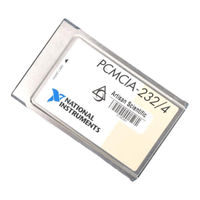National Instruments PCMCIA-232/4 Manuals
Manuals and User Guides for National Instruments PCMCIA-232/4. We have 3 National Instruments PCMCIA-232/4 manuals available for free PDF download: Getting Started
National Instruments PCMCIA-232/4 Getting Started (61 pages)
PCMCIA Serial Hardware and Software for Windows 95
Brand: National Instruments
|
Category: Computer Hardware
|
Size: 0 MB
Table of Contents
Advertisement
National Instruments PCMCIA-232/4 Getting Started (62 pages)
Brand: National Instruments
|
Category: Computer Hardware
|
Size: 1 MB
Table of Contents
National Instruments PCMCIA-232/4 Getting Started (53 pages)
Serial Hardware and Software for Windows NT
Brand: National Instruments
|
Category: Recording Equipment
|
Size: 0 MB
Table of Contents
Advertisement
Advertisement
Related Products
- National Instruments PCMCIA Series
- National Instruments PCMCIA-232
- National Instruments PCMCIA-485/2
- National Instruments PCMCIA-232/2
- National Instruments PCMCIA-485
- National Instruments PCMCIA-CAN
- National Instruments PCMCIA-CAN/2
- National Instruments PCMCIA Serias
- National Instruments PCMCIA-FBUS/2
- National Instruments NI PCI-7811R


